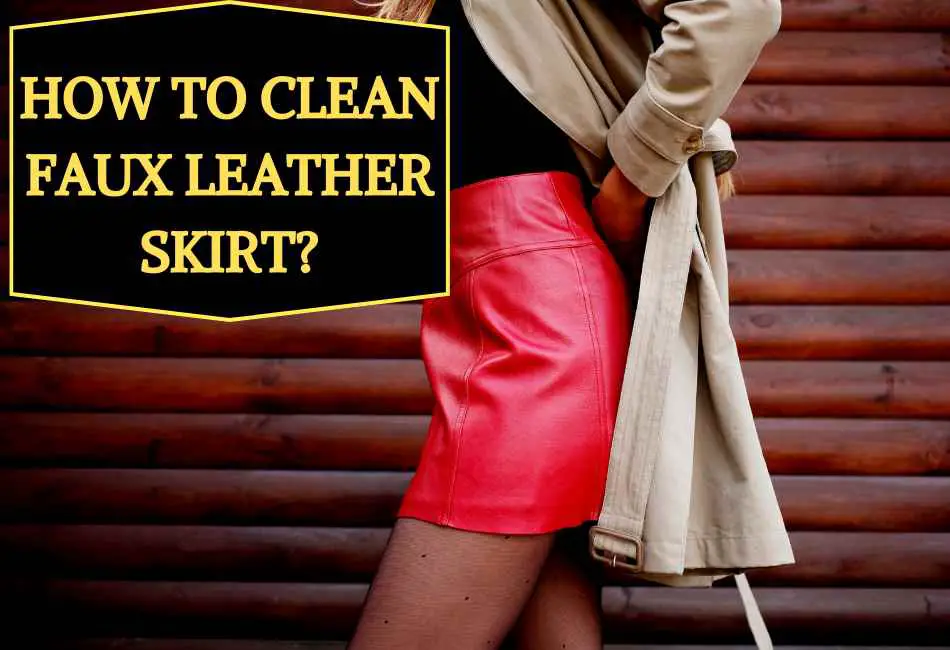Faux leather, also known as synthetic leather, is a popular material designed to mimic genuine leather’s aesthetic appeal and feel at a fraction of the cost.
Faux leather skirts have become a must-have in many fashion enthusiasts’ wardrobes due to their sleek design and affordability.
However, maintaining these skirts’ fresh and polished look requires proper cleaning and care. Improper cleaning can cause the material to deteriorate rapidly, losing its luster and flexibility.
This article delves into five handy at-home remedies to keep your faux leather skirt looking as good as new. Let’s dive right in!
Main Points: Home Remedies for Cleaning Faux Leather Skirt
Mild Soap and Water Solution
- Preparation of the Solution
I’ve found that a simple combination of soap and water can work wonders for cleaning faux leather. I typically mix two tablespoons of a mild detergent (like baby shampoo or a gentle dish soap) into a bucket of warm water.
Stir until you get some bubbles on top but not too much froth. This mild solution is generally enough to clean the surface of your faux leather skirt without damaging the material.
- Application on Faux Leather Skirt
Once the solution is ready, I dampen a soft cloth in the soapy water and gently wipe down the entire surface of my faux leather skirt.
Remember, the key is to dampen, not soak, the material. You want to avoid the risk of water seeping into the faux leather and damaging it.
- Gentle Cleaning Technique
I use a gentle circular motion that lifts dirt and stains without scratching or damaging the surface. Once I’m done, I use a dry, soft cloth to wipe off any excess moisture and then leave the skirt to air dry.
White Vinegar and Water Mixture
- Mixing Ratios for Solution
I turn to a vinegar and water mixture if the mild soap and water solution isn’t enough to clean stubborn stains.
The acidity of vinegar helps break down tougher stains. I mix equal parts of white vinegar and water in a bowl, creating a potent but safe cleaner for faux leather.
- Using a Soft Cloth for Application
The application process is similar to the soap and water method. I dip a soft cloth into the vinegar mixture and gently rub it on the faux leather skirt.
After a few minutes, I wipe the surface with a clean, dry cloth to remove vinegar residues.
- Benefits of Vinegar for Faux Leather
Vinegar isn’t just for stubborn stains. I’ve found that it can also help restore the shine and suppleness of my faux leather skirt.
The mild acidity of vinegar removes surface grime and restores the pH balance of the faux leather, helping it maintain its look and feel.
Baking Soda Paste
- Creating the Paste
Regarding extremely stubborn stains, I like to use a simple household ingredient – baking soda. I mix equal amounts of baking soda and water in a small bowl to create the paste. I aim for a consistency similar to toothpaste – not too runny, yet not too thick.
- Application on Stains
Once my baking soda paste is ready, I apply it directly to the stain on my faux leather skirt. Using a toothbrush makes this process easy, especially for smaller, more intricate areas.
- Gentle Rubbing Technique
After applying the paste, I gently scrub the stain using the toothbrush. The scrubbing should be gentle to avoid scratching the faux leather. I let the paste sit for 10-15 minutes before wiping it off with a clean, damp cloth.
Olive Oil and Lemon Juice Blend
- Mixing Proportions
I turn to olive oil and lemon juice blend for a natural cleaner and conditioner. I’ve found that a mixture of two parts olive oil to one part lemon juice works superbly. It not only cleans but also helps to maintain the shine of my faux leather skirt.
- Applying the Blend on Faux Leather
Once my blend is ready, I apply a small amount of it to a soft cloth, then wipe the entire surface of the skirt. The olive oil helps lift dirt and grime, while the lemon juice is a natural brightener.
- Buffing for Shine and Cleansing
After applying the olive oil and lemon juice blend, I wait about 5 minutes before buffing the surface with a dry cloth.
The buffing process gives the faux leather a beautiful shine and removes any remaining blend, ensuring the material is not too oily.
Cornstarch for Grease Stains
- Application on Grease Spots
There are times when I unknowingly spill some oil or butter on my faux leather skirt while cooking. When this happens, I’ve found cornstarch to be a lifesaver. Acting as a natural absorber, it is excellent at lifting grease stains. I simply sprinkle a generous amount of the cornstarch over the grease spot, ensuring it’s completely covered.
- Allowing Absorption
Once applied, patience is key. I leave the cornstarch on the grease spot overnight, giving it ample time to absorb the oil from the faux leather. The longer I wait, the more effective the results.
- Gentle Brushing to Remove Residue
In the morning, with a soft brush, I gently brush off the cornstarch. To my delight, the grease stain often lifts off with the cornstarch, leaving my faux leather skirt looking as good as new.
Sub-Points for General Application
- Common Preparation Steps for Home Remedies
Before starting the cleaning process, I ensure I have all the necessary materials ready. This includes the cleaning solution (like the baking soda paste or the olive oil and lemon blend), a clean cloth or a toothbrush, and a dry towel for drying.
- Testing in an Inconspicuous Area
One lesson I’ve learned from my cleaning experiences is that testing the cleaning solution on an inconspicuous area is always safer. This way, I can ensure the solution won’t harm or discolor my faux leather item.
- Avoiding Excessive Moisture
While moisture is necessary for cleaning, too much can damage faux leather. I always use enough solutions to clean the stain and not soak the material.
- Drying Techniques for Faux Leather
Drying is a crucial step in maintaining the longevity of faux leather. After cleaning, I thoroughly dry the item using a towel. Avoiding direct sunlight, I prefer to let it air dry in a cool, well-ventilated area.
Conclusion
Looking back at the journey we’ve embarked on together, it’s clear that faux leather maintenance doesn’t have to be a daunting task. I’ve shared my go-to remedies, from baking soda paste, olive oil, and lemon blend, to dusting cornstarch overnight on stubborn grease stains – all of which worked wonders on my beloved faux leather items. They’ve left them clean and preserved their sheen and durability.
One thing I cannot stress enough is the importance of regular cleaning. I’ve found that tackling stains as they come has saved many of my faux leather items from irreversible damage. You’ve probably heard the saying, “A stitch in time saves nine.” Well, a clean in time saves your faux leather!
One thing that makes me incredibly proud about my cleaning regime is the fact that it’s eco-friendly and cost-effective. Many items, like baking soda, olive oil, and lemon, are regular kitchen staples. We’re cleaning efficiently, reducing our carbon footprint, and saving our wallets from expensive detergents that can sometimes cause harm to our items.
Maintaining faux leather skirts, or any faux leather item, is about learning what works and consistency. Over the years, I’ve come to appreciate the beauty and versatility these items add to my wardrobe and the importance of taking care of them.
As we wrap up, I hope my journey has inspired you to care for your faux leather pieces. Remember, there’s nothing that a little TLC and some home remedies can’t fix!

